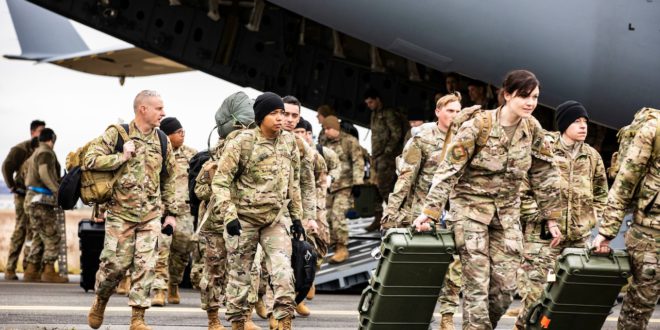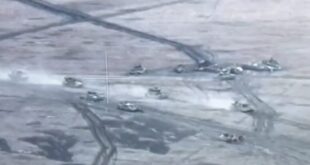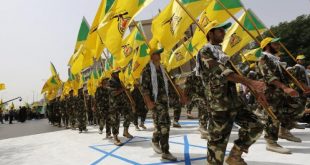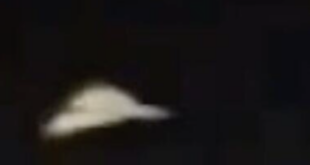Travel Alert Heightened as U.S., NATO, like a Warmonger Mafia, try to convince Ukraine President war is imminent
Do not travel to Ukraine due to the increased threats of Russian military action and COVID-19; those in Ukraine should depart now via commercial or private means. If remaining in Ukraine, exercise increased caution due to crime, civil unrest, and potential combat operations should Russia take military action. Some areas have increased risk. Read the entire Travel Advisory.
On January 23, 2022, the Department of State authorized the voluntary departure of U.S. direct hire employees (USDH) and ordered the departure of eligible family members (EFM) from Embassy Kyiv due to the continued threat of Russian military action. U.S. citizens should not travel to Ukraine, and those in Ukraine should depart now using commercial or other privately available transportation options.
There are continued reports of a Russian military build-up on the border with Ukraine, indicating potential for significant military action against Ukraine. The security conditions, particularly along Ukraine’s borders, in Russia-occupied Crimea, and in Russia-controlled eastern Ukraine, are unpredictable and can deteriorate with little notice. Demonstrations, which have turned violent at times, regularly occur throughout Ukraine, including in Kyiv.
U.S. citizens in Ukraine should be aware that the U.S. government will not be able to evacuate U.S. citizens in the event of Russian military action anywhere in Ukraine. Military action may commence at any time and without warning and would also severely impact the U.S. Embassy’s ability to provide consular services, including assistance to U.S. citizens in departing Ukraine. For more information, please review what the U.S. government can and cannot do to assist you in a crisis overseas.
The Department asks all U.S. citizens in Ukraine to complete an online form so that we may better communicate with you. This is especially important if you plan to remain in Ukraine.
Crimea – Do Not Travel
Russia occupies and has attempted to annex Ukraine’s Crimea peninsula, and there is extensive Russian Federation military presence in Crimea. Occupation authorities continue to abuse and arbitrarily imprison foreigners and the local population, particularly individuals who are seen as opposing Russia’s occupation of the peninsula. The U.S. government prohibits its employees from traveling to Crimea and is unable to provide emergency services to U.S. citizens in Crimea.
Donetsk and Luhansk – Do Not Travel
Russia-led forces control areas of the Donetsk and Luhansk oblasts, where the ongoing armed conflict has resulted in more than 14,000 deaths. Individuals, including U.S. citizens, have been threatened, detained, or kidnapped for hours or days after being stopped at checkpoints controlled by Russia-led forces. The U.S. government restricts USDH from traveling to the eastern parts of the Donetsk and Luhansk oblasts and adjacent regions, which limits the ability to provide emergency services to U.S. citizens in these regions.
Crime targeting foreigners and property is common. Politically targeted assassinations and bombings have also occurred. There are reports of violent attacks on minority groups and police by radical groups.
COVID – Do Not Travel
Visit the Embassy’s COVID-19 page for more information on COVID-19 and related restrictions and conditions in Ukraine. Read the Department of State’s COVID-19 page before you plan any international travel.
The Centers for Disease Control and Prevention (CDC) has issued a Level 4 Travel Health Notice for Ukraine, indicating a very high level of COVID-19 in the country. Your risk of contracting COVID-19 and developing severe symptoms is lower if you are fully vaccinated with an FDA authorized vaccine. Before planning any international travel, please review the CDC’s specific recommendations for fully vaccinated and unvaccinated travelers.
The Federal Aviation Administration (FAA) prohibits U.S. civil aviation from flying in the Dnipro (UKDV) Flight Information Region – Ukraine airspace that covers the cities of Donetsk and Luhansk. For more information, U.S. citizens should consult the Federal Aviation Administration’s Prohibitions, Restrictions and Notices.
If you are currently in Ukraine or plan to travel to travel, there:
Like a Warmongering Mafia, U.S., NATO trying to convince Ukraine President war is imminent
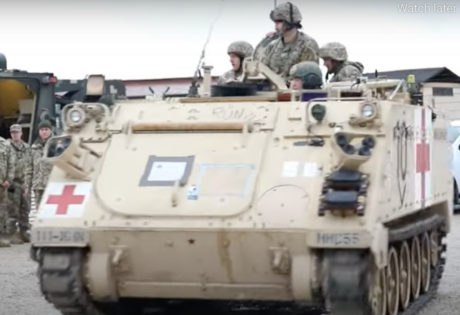
Wag the Dog War Distracts:
Biden is fiercely wagging the dog as he did in Syria during his Vice Presidency, both times in order to detract from a failing administration. This time he may be motivated to act quickly in order to prevent the freedom convoys worldwide to take off in the United States.
It remains to be seen whether this time the Americans are going to fall for the trap .
President Zelenskyy of Ukraine is attempting to Deescalate the situation because it is his country.
“Had a phone conversation with @eucopresident. Discussed current situation around “de-escalation” within all existing formats. We’re making diplomatic efforts to restore peace and continue practical cooperation in all areas. Grateful tofor the continued support, “
“Continued dialogue with @EmmanuelMacron on countering security challenges and stepping up the peace process within the Normandy format. Agreed on further joint steps to maintain Ukraine’s stability and enhance financial and economic cooperation.”
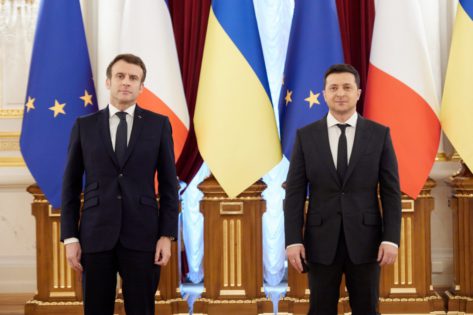
Alliances of Countries such as Hungary which cooperates on oil are being torn. Germany, France, Italy while supporting NATO and after conversations with Putin, Ukraine President, expressed ambivalence, signaling that a war is not their priority.
Once more as in Syria, Putin is warning you go into Ukraine, and you will find me there. He warns that the oil flow that Biden craves for will be hampered.
Like a Warmongering Mafia, U.S., NATO trying to convince Ukraine President war is imminent
Pentagon Spokesman Kirby said the movement of a 1,000-soldier Stryker squadron to Romania is finished, as is the movement of an 18th Airborne Corps headquarters to Germany. A “few hundred” 82nd Airborne soldiers have moved to Poland from Fort Bragg, North Carolina. Around 1,700 soldiers will deploy to Poland in the coming days.
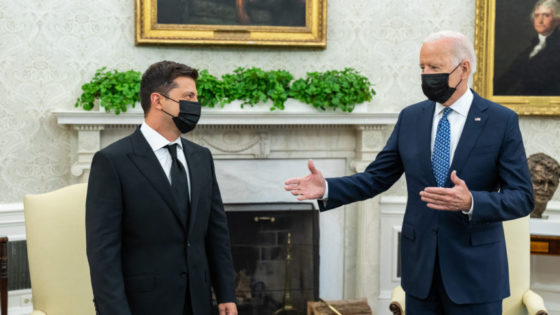
Image by The White House
Biden, the Godfather of Syria, Libya, other wars during his 50 year political career is itching for one more Wag the Dog economic boost war.
But the shady way that he is doing it is upsetting elected officials on both sides. Ukraine needs the United States And fear is that Biden is either threatening or promising help in order to break the Ukraine president down into joining Biden’s war. Biden’s tune changes every day as to whether the United States will be sending troops into Ukraine, although he is deploying and amassing Military assets
With differing reports coming from Ukraine US elected officials are demanding that Biden released the transcript between the Ukrainian president in the White House call.
President Biden: Release Jan. 6th videos. Release transcript of phone call with President Zelensky. Release transcript of call with Putin. Release transcripts of phone calls with President Xi. All of them. Now. Lou Donna
“The White House must #ReleasetheTranscript of President Biden’s call with President Zelenskyy IMMEDIATELY.”
“The White House must release the transcript of President Biden’s call with President Zelenskyy immediately.” “It was House Democrats, led by Chairman Schiff and Speaker Pelosi, who spent months wasting American taxpayer dollars on a purely partisan attack propped up by their selectively-edited call between President Trump and President Zelenskyy. Joe Biden himself called on President Trump to ‘release the transcript…let the House see it.’” “Now, as Biden’s foreign policy disasters mount, Democrats are putting another double standard on display by not releasing the transcript of President Biden’s call with Zelenskyy. To paraphrase our colleagues on the other side of the aisle, if there is nothing wrong with the call, this should not be a problem.” “President Biden’s weakness on the world stage has emboldened America’s enemies, abandoned our allies, and put us in the midst of an international crisis. Now, the Biden administration is playing a game of ‘he said, she said’ regarding yesterday’s call with President Zelenskyy.”
UPDATE JIM GARAMONE DOD
Austin spoke alongside Army Gen. Mark A. Milley, chairman of the Joint Chiefs of Staff. Both men emphasized the United States’ commitments to NATO allies and in opposition to Russian actions. “Any Russian attack or further incursion into Ukraine would not only ignite conflict, it would also violate the bedrock principles of national sovereignty, territorial integrity and self determination,” Austin said. “This is something that we’re taking very seriously both as a strong partner of Ukraine and as one of 30 members of NATO.”
Since the first Russian incursion into Ukraine and Putin’s illegal annexation of Crimea in 2014, the United States has committed more than $2.7 billion in security assistance to Ukraine. A shipment arrived in Ukraine today, Austin said.
The United States military is taking actions to support NATO allies. Part of that includes reinforcing security on NATO’s eastern flank, Austin said. “We placed thousands of U.S. troops on ‘prepare-to-deploy’ orders earlier this week,” he said. “If NATO activates its response forces, these troops will be ready to go.”
Both Austin and Milley said the 8,500 U.S. troops have not been ordered to go anywhere, yet. The troops will be part of the NATO Response Force if that unit is activated.
Milley said Russia needs to “stand down” from its position. He noted that there are more than 100,000 Russian troops on the border with Ukraine and inside Russia’s only European ally — Belarus. Ukraine is the second largest nation in Europe and has a population of 44 million. “If war were to break out on a scale and scope that is possible, the civilian population will suffer immensely,” the general said.
The Ukrainian military has about 150,000 active-duty troops and a larger number of reservists, Milley said.
Ukraine is a NATO partner, not a NATO member, but NATO leaders have told Putin that any incursion into Ukraine would trigger significant economic and diplomatic costs. “A move on Ukraine will accomplish the very thing Russia says it does not want: a NATO alliance strengthened and resolved on its western flank,” Austin said.
“The United States will contribute to NATO’s response forces. And we will coordinate with our NATO allies. We will make sure that they have the capabilities that they need to defend themselves. Article Five is clear on its point of attack against one NATO member is an attack against us all. And as President Biden has said, the United States holds this as a sacred obligation. And we will do right by that commitment.”
Austin and Milley said that while they do not believe Putin has made the decision to use the troops amassed on Ukraine’s border, he clearly has that capability.
The frontline states of NATO are, understandably, worried about Russian aggression. NATO has significant military capability, Milley said. NATO has more than 130 brigades of maneuver forces, not including U.S. forces, the chairman said. The alliance also has 93 squadrons of high-end fighters, four aircraft carriers, and many more surface combatants. “The military capability of NATO is very, very significant,” he said.
Ukraine, NATO Differ on Imminence of Russian Attack
- Jamie Dettmer. VOA weighs in.
Ukraine’s leader and his defense and security aides are assessing Russian leader Vladimir Putin’s intentions differently from many of their Western counterparts. Are they just more stoical after eight years of persistent Russian provocations and a long-running war in eastern Ukraine—or are they misreading their Russian adversary?
Washington and London have both warned the chances are high that Putin will order an invasion of Ukraine. U.S. President Joe Biden has been warning for weeks of the “distinct possibility” Russia might invade Ukraine next month, and he reiterated the point Thursday in a phone discussion with Ukraine’s Volodymyr Zelenskiy, according to the White House.
Britain’s defense secretary, Ben Wallace, says he is “not optimistic” a Russian incursion into Ukraine can be stopped. He told the BBC while visiting Berlin there was still “a chance” an invasion could be halted, but added, “I’m not optimistic.”
Russia denies it is preparing to launch a major assault on Ukraine, accusing Western powers of alarmism. The Kremlin insists the more than 100,000 troops it has deployed along Ukraine’s borders are just taking part in exercises.
But Zelenskiy appears to suspect Moscow will do something short of launching a full-scale invasion and more likely will continue to wage the highly sophisticated form of psychological and hybrid warfare it has been using against Ukraine and Europe with growing intensity for the past decade and more.
The Ukrainian president has been calling for calm ahead of Wednesday’s meeting among officials of Ukraine, Russia, Germany and France — known as the “Normandy format” — to discuss once again the Donbass region of eastern Ukraine, nearly half of which has been occupied since 2014 by Russian soldiers and armed local proxies.
Asked at a news conference Friday for foreign media about the different assessments and of a possible rift with Biden, Zelenskiy cited his concerns over Ukraine’s economy, saying that talk of an imminent invasion is adversely affecting the economy. “For me, the question of the possible escalation is not less acute as for the United States and other partners,” he said.
But he complained the media was giving the impression we have an army in the streets and “that’s not the case.” And he said Ukraine doesn’t “need this panic” because it is damaging the economy. “We may lose the current economy,” he added.
The Ukrainian leader pointedly took issue last week when the United States, Britain, Canada and Australia announced evacuations of personnel from their embassies. Zelenskiy and his aides expressed frustration, saying the withdrawal of some diplomatic staff was premature.
One official told VOA the evacuations undermined efforts to calm the fears of ordinary Ukrainians. The United States and Britain also have told their nationals to leave Ukraine.
According to Ukrainian officials, Zelenskiy has broached the issue of evacuations with U.S. officials, including U.S. Secretary of State Antony Blinken, saying the withdrawal of staff is an “overreaction” and something Russia can exploit to sow fear and to destabilize.
Aside from worries about the economy and Ukrainian morale, though, Kyiv appears to be at odds with Washington and London over Putin’s strategy, as well as over how near he is to completing a military buildup that would allow him to launch a full throttle invasion.
According to Ukraine’s foreign minister, Dmytro Kuleba, Russia doesn’t have enough troops in place to mount a full-scale invasion. He told reporters this week, “The number of Russian troops massed along the border of Ukraine and occupied territories of Ukraine is large, it poses a threat to Ukraine, a direct threat to Ukraine, however, at the moment, as we speak, this number is insufficient for a full-scale offensive against Ukraine along the entire Ukrainian border.”
Some independent Ukrainian analysts agree with Kyiv’s assessment that a full-scale invasion isn’t likely. “I don’t believe there will be a full-scale military invasion,” said Taras Kuzio, an analyst at the Henry Jackson Society, a London-based research group, and a professor at the National University of Kyiv Mohyla Academy.
“In that sense, I agree with Ukrainian military officials,” he said in a recent British television debate. “There aren’t enough troops there. Ukraine is a huge territory. It has the third largest army in Europe. And if you’re working on the basis of a three-to-one ratio of invading versus defending armies, which is the number you need to be successful, then Russia would need 500,000 to 600,000 troops to overcome Ukraine. It doesn’t have that, and it’s not projected to have that.”
Kuzio believes it is more likely Russia may mount an incursion around the Black Sea coast and expand on territory it holds in the Donbass region.
Ukrainian officials admit privately they are caught somewhat in a quandary. They need Western military assistance and materiel—from anti-tank rockets to surface-to-air missiles—and they need the West to be strong, to stand up to Putin and to deter Russia from any kind of attack, limited or otherwise. But they don’t want to talk up the threat, wreck their economy and panic their people. It is a fine line they’re walking, several officials told VOA.
Western officials say they have to be ready for all eventualities and they don’t want to be caught wrong-footed, as they were in 2014 when Russia annexed Ukraine’s Crimean Peninsula. Russia then encouraged and assisted armed proxies to seize part of the Donbass in the wake of a popular uprising that toppled Ukrainian President Viktor Yanukovych, a Putin ally.
That means, they say, reinforcing NATO’s military presence in eastern Europe, in neighboring NATO countries, and making sure everyone understands the stakes are high. “Putin is unpredictable and any gaps he sees he will jump through; any weakness, he will exploit,” a senior NATO official told VOA.
 Soldier of Fortune Magazine The Journal of Professional Adventurers
Soldier of Fortune Magazine The Journal of Professional Adventurers


